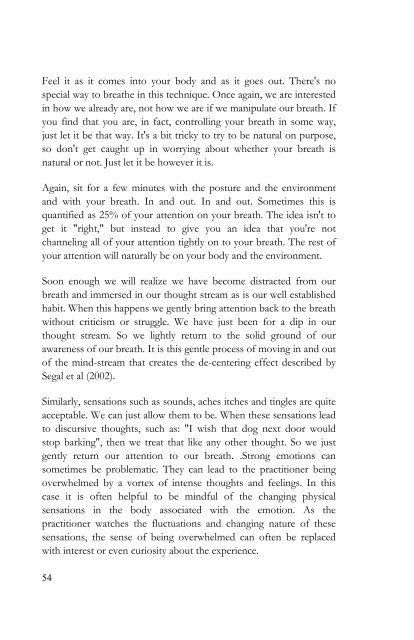Introduction to Mindfulness - Dean Amory
Art and Benefits of Mindfulness Meditation
Art and Benefits of Mindfulness Meditation
Create successful ePaper yourself
Turn your PDF publications into a flip-book with our unique Google optimized e-Paper software.
Feel it as it comes in<strong>to</strong> your body and as it goes out. There's no<br />
special way <strong>to</strong> breathe in this technique. Once again, we are interested<br />
in how we already are, not how we are if we manipulate our breath. If<br />
you find that you are, in fact, controlling your breath in some way,<br />
just let it be that way. It's a bit tricky <strong>to</strong> try <strong>to</strong> be natural on purpose,<br />
so don't get caught up in worrying about whether your breath is<br />
natural or not. Just let it be however it is.<br />
Again, sit for a few minutes with the posture and the environment<br />
and with your breath. In and out. In and out. Sometimes this is<br />
quantified as 25% of your attention on your breath. The idea isn't <strong>to</strong><br />
get it "right," but instead <strong>to</strong> give you an idea that you're not<br />
channeling all of your attention tightly on <strong>to</strong> your breath. The rest of<br />
your attention will naturally be on your body and the environment.<br />
Soon enough we will realize we have become distracted from our<br />
breath and immersed in our thought stream as is our well established<br />
habit. When this happens we gently bring attention back <strong>to</strong> the breath<br />
without criticism or struggle. We have just been for a dip in our<br />
thought stream. So we lightly return <strong>to</strong> the solid ground of our<br />
awareness of our breath. It is this gentle process of moving in and out<br />
of the mind-stream that creates the de-centering effect described by<br />
Segal et al (2002).<br />
Similarly, sensations such as sounds, aches itches and tingles are quite<br />
acceptable. We can just allow them <strong>to</strong> be. When these sensations lead<br />
<strong>to</strong> discursive thoughts, such as: "I wish that dog next door would<br />
s<strong>to</strong>p barking", then we treat that like any other thought. So we just<br />
gently return our attention <strong>to</strong> our breath. .Strong emotions can<br />
sometimes be problematic. They can lead <strong>to</strong> the practitioner being<br />
overwhelmed by a vortex of intense thoughts and feelings. In this<br />
case it is often helpful <strong>to</strong> be mindful of the changing physical<br />
sensations in the body associated with the emotion. As the<br />
practitioner watches the fluctuations and changing nature of these<br />
sensations, the sense of being overwhelmed can often be replaced<br />
with interest or even curiosity about the experience.<br />
54

















